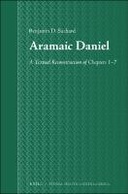Explore

The first half of the book of Daniel contains world-famous stories like the Writing on the Wall. These stories have mostly been transmitted in Aramaic, not Hebrew, as has the influential apocalypse of Daniel 7. This Aramaic corpus shows clear signs of multiple authorship. Which different textual layers can we tease apart, and what do they tell us about the changing function of the Danielic material during the Second Temple Period? This monograph compares the Masoretic Text of Daniel to ancient manuscripts and translations preserving textual variants. By highlighting tensions in the reconstructed archetype underlying all these texts, it then probes the tales’ prehistory even further, showing how Daniel underwent many transformations to yield the book we know today.
This book is included in DOAB.
Why read this book? Have your say.
You must be logged in to comment.
Rights Information
Are you the author or publisher of this work? If so, you can claim it as yours by registering as an Unglue.it rights holder.Downloads
This work has been downloaded 56 times via unglue.it ebook links.
- 56 - pdf (CC BY-NC) at Unglue.it.
Keywords
- Afro-Asiatic languages
- apocalypse
- Apocalyptic
- Aramaic
- Belshazzar
- Bible
- biblical
- burning
- court
- Criticism
- danielic
- fire
- furnace
- Historical & comparative linguistics
- Humanities
- Judaism
- Judaism: sacred texts
- Language
- Language qualifiers
- Linguistics
- maccabean
- Nabonidus
- Nebuchadnezzar
- Philology
- Religion & beliefs
- Semitic Languages
- Son of Man
- Tales
- thema EDItEUR::2 Language qualifiers::2C Afro-Asiatic languages::2CS Semitic languages::2CSA Aramaic
- thema EDItEUR::C Language and Linguistics::CF Linguistics::CFF Historical and comparative linguistics
- thema EDItEUR::Q Philosophy and Religion::QR Religion and beliefs::QRJ Judaism::QRJF Judaism: sacred texts and revered writings
Links
DOI: 10.1163/9789004521308Editions

